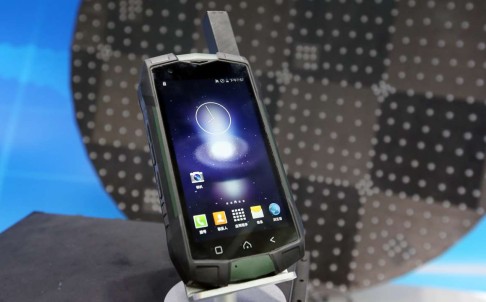| 天通一号手机卫星的手机亮相珠海,可同时接5千手机通话 |
| 送交者: 2016年11月08日02:04:46 于 [世界军事论坛] 发送悄悄话 |
|
|
Chinese aerospace giant unveils first smartphone for country’s satellite communications networkLaunch linked to ‘space-based Silk Road’ strategy PUBLISHED : Sunday, 06 November, 2016, 8:03am UPDATED : Monday, 07 November, 2016, 9:57pmOne of China’s top aerospace technology companies unveiled the first satellite smartphone designed for use with the country’s a first mobile communications satellite, Tiantong-1 (TT-1), at the six-day Airshow China in Zhuhai, Guangdong, which wraps up on Sunday. The new smartphone, developed by state-owned China Aerospace Science and Technology Corporation (CASC), is scheduled to go on sale in two to three months, where it will compete in a global market dominated by the British Inmarsat system. We are going to expand our coverage to the whole world by launching a network TT satellites in the next five years CASC launched TT-1 into an equator-hugging, geostationary orbit about 35,000km above the earth on August 6. Satellite experts said the new satellite smartphone was a product of the “space-based Silk Road”, a long-term strategy proposed by Chinese aerospace companies, institutions and scholars to support the country’s “One Belt, One Road” initiative. “The TT-1 smartphone is so far capable of covering the territory of China and the whole South China Sea,” an engineer from CASC’s Fifth Academy, based in Xian, Shaanxi province, said. “We are going to expand our coverage to the whole world by launching a network TT satellites in the next five years, because our ultimate goal is to replace Inmarsat, or even surpass it.” The engineer said the smartphone was specially designed for emergency communication by field geologists or relief workers in remote areas, or when ground telecommunication networks were interrupted by natural disaster or accidents. “Our product also supports the US Global Positioning System and our home-developed Beidou navigation system,” he added. Besides satellite coverage, the smartphone is compatible with multiple ground-based cellular networks, including 4G LTE and 3G, supports SMS, WeChat, video and data transmission, and allows free switching between satellite and ground communication.
The smartphone will retail from around 10,000 yuan, with communication fees starting from around 1 yuan a minute, a tenth of the price charged by Inmarsat. Professor He Qisong, a satellite expert at Shanghai University of Political Science and Law, said the development of the satellite smartphone indicated that China was starting to carry out its global strategy by setting up an independent communication network from ground to space. “The ‘space-based Silk Road’ is one of the applications of the ‘One Belt, One Road’ initiatives by providing an independent and secure, but convenient and low-cost communication network for those Chinese companies that are expanding into overseas markets at Beijing’s urging,” He said. “I believe Chinese companies in the Middle East will be potential clients of the TT-1 smartphone service because China’s Beidou system is also targeting the market in the region.” Earlier reports from Xinhua said the Tiantong system had reached users in China, the Middle East, Africa and other regions. CASC says the network’s ground service will be operated by China Telecom. Another state-owned aerospace giant, China Aerospace Science and Industry Corporation (CASIC), which focuses on missile development, unveiled the export version of its advanced YJ-12 supersonic anti-ship cruise missile – the CM-302 – at the air show. Dubbed China’s carrier killer, the missile is also capable of attacking ground targets. Potential clients from the Middle East, including a delegation from the Royal Saudi Air Force leaders, inspected the missile at the air show on Wednesday. China showcased more than 900 home-made weapons to potential customers in Asia and Africa at the biennial show, according to the event’s organiser. The air show featured more than 700 exhibitors from more than 42 countries and regions – with more than 400 exhibitors from China alone. |
|
|
 |
|||||
|
 |
| 实用资讯 | |
|
|
| 一周点击热帖 | 更多>> |
| 一周回复热帖 |
| 历史上的今天:回复热帖 |
| 2015: | 龙凯锋:习马会后,民进党2016年赢得大 | |
| 2015: | 评论:习马会压缩绿营对两岸的模糊态度 | |
| 2014: | 嫦娥五号T1成功“漂回”让国人对美国登 | |
| 2014: | 有些意思,李世默:兩種制度的傳說 Eric | |
| 2013: | 《大国重器》 20131108 第三集 赶超之路 | |
| 2013: | 海默:中国若敢扩张到美国家门口的必然 | |
| 2012: | 热闹的十八大:各地民众热烈“围观”靓 | |
| 2012: | 星星还是那个星星,月亮还是那个月亮, | |
| 2011: | 辛丑条约再现:北约向利比亚提出4800亿 | |
| 2011: | 南海局势紧张:中国海军第二艘071巨舰抵 | |





